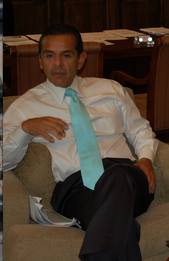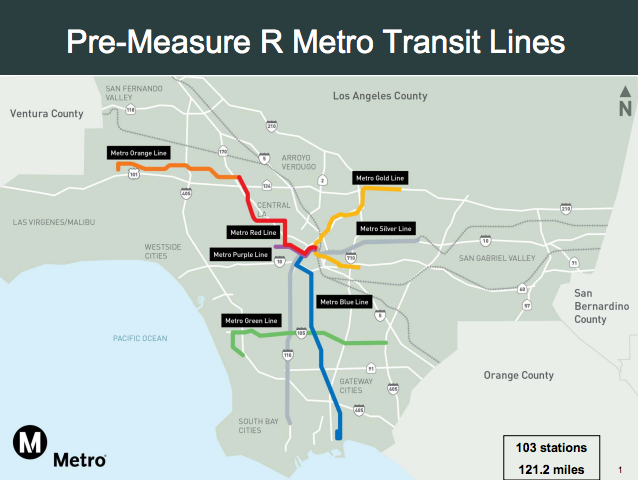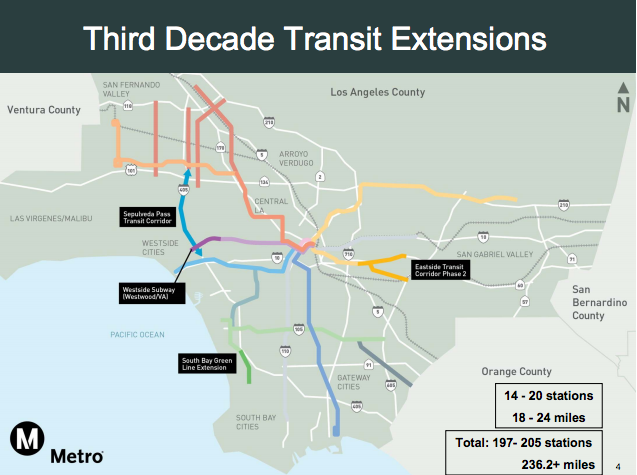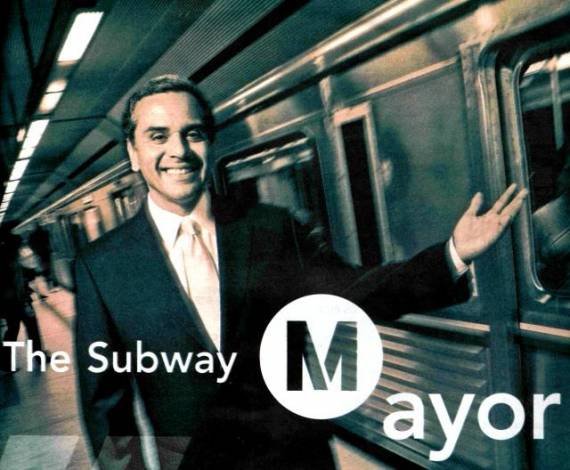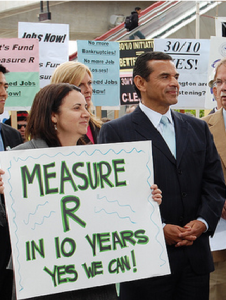The Villaraigosa Interview II: The Subway Mayor Triumphant
10:36 AM PDT on July 25, 2012
One of the major themes of Streetsblog's recent interview with Mayor Antonio Villaraigosa was the timeline for transit expansion. Rather than an outline of when projects would be completed, we sought to chronicle the policy switch from moving cars to a true pro-transit agenda. Was it when Villaraigosa was elected to the City Council and chaired the Transportation Committee? Was it when he first ran for mayor, when transit expansion was a major plank in his unsuccessful campaign? Was it in 2008, when the ability to fund a real transit expansion plan suddenly seemed possible?
To hear Villaraigosa tell it, creating a working and integrated transit system was always something he dreamed about.
“When I was five years old, I rode the bus from City Terrace to Downtown L.A. to shine shoes. I had to take the bus to 7th and Hope to go to the YMCA,” the mayor remembers. “My mother had nothing but a bus. I want to make sure that buses are safe. I want to make sure buses are clean.”
But it won’t be his record on buses--one defended by Villaraigosa but excoriated by advocacy group the Bus Riders Union (BRU)--for which the mayor is remembered. It will be his ambitious rail and bus rapid transit expansion plans, and how those projects will change Los Angeles.
In 2005, the L.A. Weekly published “The Subway Mayor,” a piece profiling the long odds that Villaraigosa would face if he pursued his campaign promise of a “Subway to the Sea.” For a subway extension to occur, the mayor would need to get a federal law changed that banned subway construction in many parts of the Westside, defeat the BRU both politically and in the courtroom, find a major source of funding, and overcome resistance from Westsiders. While “The Subway Mayor” reads as generally supportive of increasing rail transit, it also makes the odds against such a proposal sound insurmountable.
So far, Villaraigosa has run the table...and then some.
While the mayor chaired the Metro Board of Directors from July 1, 2005 until June 30, 2006, the transportation projects were either “stalled” or “stale,” to use the terms from his interview preparation notes. The most exciting projects were stalled. The projects that were moving were stale.
For most of that period, Metro was in transition. The agency was still operating under a ten-year federal consent decree signed in 1996 by the agency and the BRU to head off a civil rights lawsuit filed by the BRU. The decree required Metro to expand its bus service to such a degree that any dramatic increase in rail service was impossible. While the clock ran down on the consent decree, Villaraigosa began to lay the groundwork for the Measure R Campaign.
"I knew we could never get anything passed on public transportation if we didn't continue the fight on buses," Villaraigosa remarked. At the same time, he pushed Congressman Henry Waxman at the federal level and Zev Yaroslavsky at the county level to change laws put in place that would stymie any attempt at the Westside Subway.
Rather than attack either revered Westside politician, Villaraigosa appealed to their rational side. “The science has changed (since 1985),” he pleaded. In the end, he won the repeal of both a federal law banning subway construction through parts of the Westside and a county law banning certain funds from being used for subway construction.
Step One: Done.
By the time Move L.A. and Denny Zane held the “It's Time to Move L.A.” conference in January of 2008, the unofficial kickoff for the Measure R sales tax campaign, the discussion was already beginning to change. The consent decree was off the books and Metro was pushing large cuts to its bus service hours. At the same time, opposition to the sales tax proposal was already growing.
As expected, the BRU fought the proposal, despite 20% of the sales tax going for transit operations. While many urbanists have praised Metro and Villaraigosa for the vision and strategy needed to create a real-life rail plan for the city, the BRU has stuck to their guns, criticizing Metro every time a new service cut for buses has been announced. Even as this interview is published, Streetsblog reporters are covering a BRU rally outside of City Hall calling for the restoration of bus service.
"By the way, I wanted more money for operations but I couldn't get the votes for it,” Villaraigosa argues. “I wanted to freeze the bus fares for everyone, but I couldn't get the votes for it.
I think the best way to increase ridership as gas prices go up is to keep the system costs low. The naysayers will argue that it's too low as it is, that all these other cities have higher prices. This city is so committed to the single-passenger automobile that the only way to do that is to drive down the cost of buses when car usage is going up.”
Instead, Measure R held fares at their current level for five years and flatlined fares for seniors and lower-income riders for longer than that. There isn’t a public breakdown on how Measure R+, the shorthand for the plan to expand Measure R taxes for another 30 years, would impact fares.
Joining the Bus Riders Union in opposition was a coalition of public officials from the San Gabriel Valley, most vocally, County Supervisor Gloria Molina. “They didn’t understand it, so they were against it,” Villaraigosa remembers. Indeed, one of Streetsblog’s favorite pictures from the Measure R debate was a group of San Gabriel Valley politicians holding “anti-Measure R” signs that included one that read “Gold Line Now!” The construction of the Gold Line extension currently underway would not be possible if not for Measure R dollars.
For Villaraigosa, the Measure R campaign was about more than building a transportation system for L.A. County. It was a referendum on the future of the city and on his mayorship.
"When you look at Measure R...” the mayor began. “I ran on doubling the size of the rail system. If you look at Measure R, that's what I ran on."
Measure R survived the legislative process, barely. Enabling legislation, based in part on a 2004 Senate Bill written by Culver City Democrat Kevin Murray, squeaked through Sacramento, passing each house by just one vote. Without the aggressive campaigning of Assemblyman Mike Feuer, Measure R might have died before it was even born. Similarly close votes were held by the Metro Board of Directors and the L.A. County Board of Supervisors.
In the end, Measure R, a half-cent sales tax for all of L.A. County for the next thirty years, was placed on the ballot. It needed ⅔ support to pass. It ended up with 67.1% of the vote.
“We got it passed; we changed the game,” the mayor celebrated. For Villaraigosa, the vote was more than just a sales tax. It was a matter of legacy. Despite his protestations that he doesn’t think about that sort of thing, Measure R allowed the man L.A. Weekly dubbed “the Subway Mayor” to actually advance a subway. Measure R made many of the mayor’s railway promises possible.
Measure R funds twelve transit expansion projects, including: the recently completed Orange Line Bus Rapid Transit extension to Chatsworth; an extension of the Purple Line subway to the V.A. Hospital; a plan to connect the Green Line to LAX; and more. It also funds highway expansion projects, including a pair of controversial expansions of the I-710 and the High Desert Corridor in the Antelope Valley.
These expansion projects are aimed at increasing connectivity between one of the largest, most diverse, and most populous counties in the nation. According to Villaraigosa, such serious efforts to improve transportation will "bring Angelenos together."
Neither rail advocates nor the mayor were given long to celebrate. "Almost from the beginning, people started saying to us, ‘Hey, you passed Measure R. Where's your Subway to the Sea at?’" remembers Villaraigosa. Nevermind that Measure R funds didn’t cover the cost of a subway all the way to Santa Monica, much less “the sea.”
Worse than the catcalls in the press, many of the same politicians and groups that opposed Measure R shifted their focus to opposing Metro’s 2009 Long Range Transportation Plan, a document needed before Metro could apply for federal funds for any project, regardless of Measure R.
Out of the need to get a divided Metro Board to approve the Long Range Transportation Plan came the 30/10 initiative, a plan to speed up the construction of thirty years’ worth of Measure R projects in ten years through government loans and bonds. Unfortunately, the plan required some pretty substantial changes to federal law.
"We can't even get these guys to agree to a long range plan because everybody's afraid the project in the early years will stop the projects in the later years,” Villaraigosa remembers. “So what if we agree to accelerate the transit projects in a shorter period of time to get these guys to trust (in the plan.)”
And just like that, “30/10” was born.
“At first, nobody on the board was for this. Everyone thought we were nuts. ‘Are you freakin' crazy? It's an earmark!’” was what the mayor’s team was told. But after a year of meetings, both public and private, and a public relations campaign orchestrated with the Move L.A. Campaign, environmentalists and unions, Villaraigosa had the support of key leaders in Washington, D.C. With United States Transportation Secretary Ray LaHood and Senate Environment and Public Works Chair Barbara Boxer on board, getting support from reluctant Metro Board Members was easier than it was in the fall of 2009.
While the politics of the Long Range Plan were debated, Villaraigosa and Move L.A. worked on refining the 30/10 plan. For all of the knocks the mayor’s taken on his public speaking over the years, his recall in this part of the interview is amazing. He brings up all these numbers from a debate that happened three of four years ago from memory.
“We contracted really smart guys around the country and they came up with the notion that there's a TIFIA (Transportation Infrastructure and Finance Innovation Act) program that's underfunded. It's $122 million. You need to triple it and do a bond program that helps us loan against…bond against…the future. Incentivize localities in the middle of a recession to put up their own money to create a 30 to 1 leverage,” Villaraigosa remarked. “That's why America Fast Forward creates a million jobs. Because it's a multiplier factor.”
When Congress finally passed a transportation funding bill this year, it didn’t have all of Villaraigosa’s proposals, but the TIFIA loan program was increased to a billion dollars a year.
Meanwhile, it took a year, but the Board of Directors passed Metro’s Long Range Plan, unanimously, in October of 2009. And when it came time to apply for federal funding, the projects at the top of the list were the Regional Connector and the Westside Subway. "As oppositional as everyone was to the subway and RC, we made those the two New Startsprojects because everyone knew they were the best projects in the federal formula.” New Starts is a federal grant program available to new projects in their early phases. In the president’s fiscal budget for this year, the Westside Subway receives a $75 million grant and the Regional Connector, one for $50 million.
Unlike congestion pricing (see “Building a New Transportation System”), 30/10, or America Fast Forward (as it was re-branded in January of 2011), was popular with Democrats and Republicans alike. It also gave Villaraigosa, who was soon elected as president of the National Association of Mayors, a platform and issue to raise his own profile. Some argue that the Subway Mayor is more popular nationally than he is locally.
"The brilliance of the strategy is that it appealed to both Democrats and Republicans,” Villaraigosa explains. “In a time of high deficits and debt, they're not putting up their own money…The default rate on these loans is 2%."
But just because a plan has bipartisan support doesn’t mean it’s going to get passed. Especially in Washington, D.C. As bickering over the transportation bill, energy policy, oil pipelines, and greenhouse gases continued, the mayor and his allies began to work on an acceleration backup plan.
In June of 2011, when Streetsblog last interviewed Villaraigosa, we asked if there was a Plan B for America Fast Forward and if so, what was it? The mayor laughed at our question, replying that there’s always a Plan B. But he wouldn’t tell us what it was.
His laughter makes a lot more sense now. Streetsblog had unknowingly used the same term, “Plan B” the mayor’s team used. We also know why he didn’t want to talk about the plan then. According to the mayor, he didn’t want “Plan B,” now known as Measure R+, to take away from the sense of urgency in Washington, D.C.
It now looks like the mayor’s team might have played this perfectly. While they laid the groundwork for a campaign to extend Measure R at the ballot box and use the increased revenue to build transit faster, he also got a victory in Washington, D.C.
“Once we got [House Transportation Committee Chair John] Mica and everyone on board, it looked like TIFIA was going to happen," the mayor supplied. Indeed, even as a first draft of Mica’s transportation bill was savaged for its strident partisanship, Villaraigosa publicly thanked Mica for including the TIFIA expansion provision, providing a little partisan cover for the embattled Congressman.
When all the dust settled, the final transportation bill did include the TIFIA loan program, and Villaraigosa could thank Boxer and Mica and renew the effort locally to extend Measure R.
"We thought they were going to pass this,” the mayor said of the federal transportation bill. “A couple of weeks ago we started to wonder. [laughter] We said, ‘Hey, no matter what let's start moving the extension of Measure R. It's the best way, not just to build projects, but also to build the coalition needed.’ Some of these people don't care about transit, but they can get highway projects accelerated, too."
As Streetsblog has pointed out, there are a lot of hurdles facing the extension of Measure R. Some, including votes in the State Assembly and Metro Board of Directors, have already been passed. Others, including votes by the State Senate and L.A. County Board of Supervisors, still need to be crossed. And, of course, the Governor could blow the whole thing up by refusing to sign the needed enabling legislation.
After all that, it still needs a ⅔ vote in November to become law.
Surprisingly, the Metro Board of Directors passed the extension easily, with a 10-3 vote. "As much as some of them wanted to be against it, they realized all the jobs they're going to get out of it. 400,000 in the middle of a recession," Villaraigosa rationalized. He also doesn’t see opposition coming in Sacramento. "It doesn't hurt Governor's tax plan; we already polled that."
As for the Supervisors, he notes that even though they delayed a vote last week, it should come sooner rather than later. "The Supervisors, even if they're not for it, they're ministerial. They have to vote for it." Three of the five Supervisors, Mike Antonovich, Don Knabe, and Mark Ridley-Thomas, voted against the plan to place the extension on the ballot at the Metro Board of Directors. In 2008, Knabe voted against placing the tax on the ballot at Metro, but for it at the Board of Supervisors. Apparently, Knabe believes the Supervisors’ role is ministerial as well.
But will it pass on the fall ballot? Measure R barely made it in 2008, and there are many factors to consider. Villaraigosa is confident, “People’s taxes aren’t going to go up...and everyone benefits from building these projects sooner...If we can get there in 10 years rather than 30, when it's so far down the line, more than a generation...People don't understand the impact.”
But all of this transit expansion isn’t just about providing people with transportation options, it’s about changing the way the city grows. From now on, the city has the opportunity to grow around transit projects and transit hubs.
"What did we used to do? We built a line, we have a transit station,” Villaraigosa remembers. Dropping into his Eeyore/Huckleberry Hound voice, “Then ten years later, someone said, ‘Hey we should develop around here.’"
But, the future is going to be different, he promises.
"L.A. is going to be a city that grows around its transit stations. That's the best way to improve ridership. If people are living there, even if they own a car, they say it's just so easy to take a train, take a bus."
Right now, there’s a lot of opposition to the idea that L.A. will grow around its transit hubs. The much-ballyhooed Hollywood Plan that calls for just that is facing a trio of lawsuits. And, of course, the Westside Subway, Expo Line Phase II, and even the Expo Bike Path face challenges in the courts.
For this article, Streetsblog has borrowed the term “the Subway Mayor” from a 2005 edition of L.A. Weekly. The article lists the daunting challenges Villaraigosa would face if he truly tackled changing L.A.’s infrastructure and car culture. For the past seven years, he’s faced catcalls and skeptics, including a number of articles here in Streetsblog. But, when compared to the picture painted in that 2005 article, things have changed dramatically.
Even former aide and former Mayoral Candidate Austin Beutner scoffed when asked about America Fast Forward by a Streetsblog reporter last year.
When asked if he feels any vindication, Villaraigosa demurred and pointed to the hard work of his staff, especially Borja Leon, Metro Board Member Richard Katz, and LADOT General Manager Jaime de la Vega.
“I don't really think about that. Among ourselves, our staff, we don't really talk about it. We have a story to tell, but I'll let all the workers focus on that,” he said gesturing at Deputy Press Secretary Barb Solish. “This is their time, too, and they're all working for half of what they would outside of government. They want to be associated with something big."
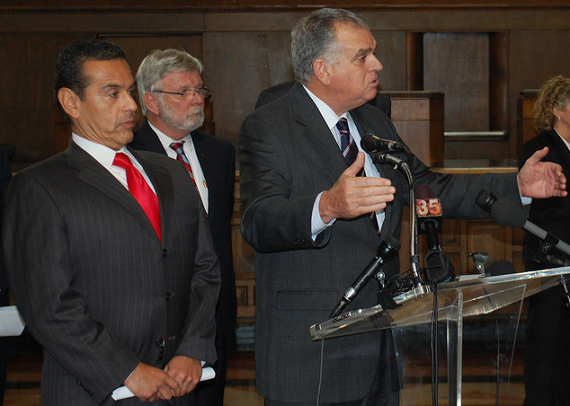
Assuming Measure R+ is on the ballot and passes, the mayor’s transit legacy is assured. So what’s left for the Subway Mayor? “My goal is to convince the Congress we need to spend more money on operations. That’s going to take more time.”
Was he hinting that he might be sitting at a different desk in Washington, D.C. next year at this time? Villaraigosa brushed that one off with a hand motion. Regardless, Streetsblog will check in with Mayor Villaraigosa for another sit-down interview next summer, after he’s termed out of office. Whether that interview will be conducted by Damien Newton (in Los Angeles) or Tanya Snyder (in the Capital) remains to be seen.
(This piece was edited by Joe Linton and Sahra Sulaiman.)
Stay in touch
Sign up for our free newsletter
More from Streetsblog Los Angeles
Metro Board Funds Free Student Transit Pass Program through July 2025
Metro student free passes funded another year - plus other updates from today's Metro board meeting
Eyes on the Street: New Lincoln Park Avenue Bike Lanes
The recently installed 1.25-mile long bikeway spans Lincoln Park Avenue, Flora Avenue, and Sierra Street - it's arguably the first new bike facility of the Measure HLA era
